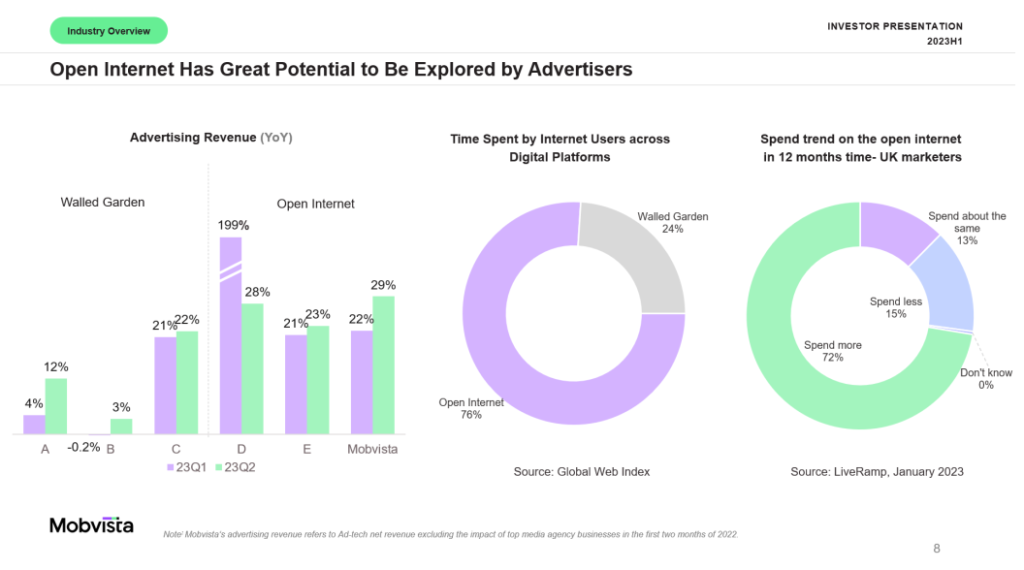What the dual ecosystems of the Walled Garden and Open Internet offer marketers in the coming years, and how to navigate the terrain ahead.
Since Google’s notable announcement to start phasing out third-party cookies by 2024, the advertising industry has been gearing itself up for the far-reaching consequences of this decision and what it will mean for the Walled Garden and Open Internet ecosystems.
Bellwethers of the industry like Meta and Google favour the well-trodden path of the Walled Garden ecosystems, which operate as a closed platform where the platform provider has total control over the content and media, and restricts access for users to outside sources as they see fit.
This year has witnessed a revival of these advertising giants who thrive within their Walled Gardens. Both Meta and Alphabet recently reported a 12% and 3% increase in ad revenue for the second quarter to US$31.5 billion and US$58 billion respectively, recording continuous positive growth.
One might wonder what the implications are on third-party platforms in the Open Internet, which refers to an environment where digital advertising can reach a wide range of audiences across various websites and platforms without being limited to a closed area, but reality shows an interesting trend where third-party platforms are exhibiting net revenue growth that surpasses even the industry giants.
The potential for growth in both the Walled Garden and Open Internet is boundless, and both ecosystems have much to offer. Having an in-depth understanding of their nature and the opportunities available will be key to navigating the marketing landscape amidst the tides of rapid change.

Peeking into the Walled Garden
The Global Web Index reveals that Walled Gardens encompass only a quarter of the user market, leaving the remaining three-quarters on third-party platforms with equal access to the Open Internet. However, advertising budgets are inversely allocated, with giants receiving nearly 80% and third-party platforms just 20%.
Despite having a relatively smaller user base, Walled Gardens and large media platforms hold higher ad value due to better results for advertisers compared to Open Internet placements. These industry leaders have honed their ability to harness data usage on their platforms, providing advertisers with a more precise and efficient means of targeting their audiences. Their comprehensive data capabilities, combined with mature ad systems and tailor-made product offerings, have created an ideal environment for monetization, particularly within the sphere of social media.
Social media’s exponential growth in user base, projected to skyrocket to nearly 5.85 billion by the year 2027, underscores the unparalleled reach that these platforms offer. Their wide-reaching impact ensures that each advertisement, even with fewer views or user interactions, yields a substantial return on investment (ROI), making them an indispensable avenue for advertisers seeking impactful campaigns. Hence, while Walled Gardens and major media platforms may boast a smaller overall user base in comparison, they hold an intrinsic value for advertisers due to their ability to deliver high ROI as a result of social media’s pervasive reach.
The allure of the Open Internet
That said, it would be myopic to dismiss the blue ocean that is the Open Internet.

Our data, as illustrated in the graph above, shows the rapid growth of third-party platforms who have ventured into the Open Internet ecosystem. A and B on the left represent traditional giants, while C, another substantial player, is relatively new to the advertising domain and has exhibited rapid growth. Meanwhile, on the right, the net advertising revenue of third-party platforms are outpacing even the giants in growth.
Furthermore, Walled Garden ecosystems, only encompass a fraction of the expansive user market. According to Alphabet and Meta’s 2021 annual report, consumers across APAC spend 59% of their time online beyond search and social on the Open Internet. This disparity serves as a stark reminder that a significant portion of the user base remains untapped, hinting at a substantial opportunity for growth and innovation in the advertising space.
While there is currently a mismatch between ad spending and user market which can be traced back to historical trends that favored first-party platforms, a compelling shift is underway. Considering the broader advertising landscape, these two figures will eventually align, indicating substantial potential for third-party advertising platforms to carve out their niche and offer distinct advantages in reaching a broader audience.
Open sesame: Unlocking opportunities in the Open Internet
To harness the full potential of the Open Internet, one fundamental approach is the continual refinement of algorithms that align advertisements with users’ limited data contributions. Given the sparse data landscape on the Open Internet, algorithms must forge more profound connections between ads and users. The advancement of AI equips us with an array of tools to bolster this alignment, fostering more effective matches.
One of the most transformative aspects of AI in advertising is Machine Learning (ML). ML empowers brands to make data-driven decisions with their campaigns which improve personalization and targeting, drive predictive analytics that can anticipate future behavioral trends, and even rapidly identify and fight against ad fraud. For instance, Mobvista utilizes ML seamlessly and comprehensively, covering multiple aspects of an advertiser’s services. From creative generation to advertising recommendations and bid optimization, we provide a comprehensive suite of applications dedicated to optimizing outcomes. We have also chosen to integrate generative AI, a powerful branch of ML, in our journey to revolutionize and enhance overall creative production efficiency. To embark on this journey, we have started with assisted or automated real-time production of advertising materials, with a focus on AI-generated images and image processing. As one can see, the applications and benefits of ML are extensive; significantly boosting campaign efficiency, reducing costs, and ultimately creating more engaging experiences for audiences.
Understanding the path ahead
In navigating the dual ecosystems of the Walled Garden and Open Internet, each terrain possesses its unique advantages. The key lies in understanding the distinct opportunities and benefits that they bring, and discerning what is best for your business’ marketing objectives.
In the end, be it the Walled Garden or Open Internet, technologies like AI will play a pivotal role in helping brands thrive in this dynamic digital era and sharpen our sights for what is to come. The future belongs to those who can harness the digital revolution and carve out a competitive advantage for themselves.


















